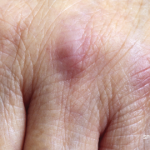I found the last study question in Table 2 less relevant to clinical practice. That a change in pain did not influence the abbreviated HRQOL was not surprising because effective pain management has more to do with how individuals deal with pain (which might be viewed as QOL) than whether they are able to reduce it, and the intensity of chronic pain varies over time. I wonder why the mobility and function scales were not all removed to form an abbreviated AIMS2 focusing on mood and psychosocial factors. Given the measures used, it also isn’t surprising that a change in mobility influenced the abbreviated QOL that included function. I would be interested to know if mood and psychosocial factors, as an abbreviated scale, were influenced by a change in mobility and function. Even with these remaining questions, I believe the study results lend strong support for teaching persons with OA to use GIR to improve QOL.
New Mouse Model for RA
By Mary Corr, MD
Kawane K, Ohtani M, Miwa K, et al. Chronic polyarthritis caused by mammalian DNA that escapes from degradation in macrophages. Nature. 2006 Oct 26;443(7114):998-1002.
Abstract
A large amount of chromosomal DNA is degraded during programmed cell death and definitive erythropoiesis. DNase II is an enzyme that digests the chromosomal DNA of apoptotic cells and nuclei expelled from erythroid precursor cells after macrophages have engulfed them. Here we show that DNase II-/-IFN-IR-/- mice and mice with an induced deletion of the DNase II gene develop a chronic polyarthritis resembling human RA. A set of cytokine genes was strongly activated in the affected joints of these mice, and their serum contained high levels of anti-cyclic citrullinated peptide antibody, rheumatoid factor, and matrix metalloproteinase-3. Early in the pathogenesis, expression of the gene encoding tumor necrosis factor (TNF)-a was upregulated in the bone marrow, and administration of anti–TNF-a antibody prevented the development of arthritis. These results indicate that if macrophages cannot degrade mammalian DNA from erythroid precursors and apoptotic cells, they produce TNF-a, which activates synovial cells to produce various cytokines, leading to the development of chronic polyarthritis.
Commentary
A new model of murine arthritis involves aberrant macrophage degradation of engulfed DNA. The appropriate handling and removal of DNA-protein complexes from sites of rapid cell turnover or cell death is quintessential for healthy tissue homeostasis. Several nucleases are responsible for removing DNA from nuclear antigens, and disrupted clearance of nuclear DNA complexes may initiate and perpetuate autoimmune disease. Indeed, mice deficient in DNase 1, the major nuclease present in serum and urine, develop anti-nuclear antibodies, deposition of immune complexes in glomeruli, and full-blown glomerulonephritis. However, Kawane and colleagues report a different phenotype in mice with an induced deletion of DNase II. DNase II is an enzyme largely expressed by macrophages that digest the chromosomal DNA of phagocytosed nuclei or nuclear material from apoptotic cells and erythroid precursor cells. DNase II-/- mice develop a lethal anemia unless they are intercrossed with mice deficient for the type I interferon receptor (IFN-IR). The doubly deficient DNase II-/-IFN-IR-/- mice survive into adulthood, but develop a robust chronic polyarticular arthritis.

